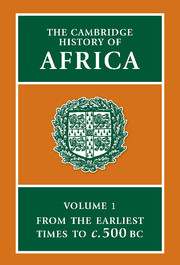Book contents
- Frontmatter
- 1 The palaeo-ecology of the African continent: the physical environment of Africa from earliest geological to Later Stone Age times
- 2 Origins and evolution of African Hominidae
- 3 The earliest archaeological traces
- 4 The cultures of the Middle Palaeolithic/Middle Stone Age
- 5 The Late Palaeolithic and Epi-Palaeolithic of northern Africa
- 6 The Later Stone Age in sub-Saharan Africa
- 7 The rise of civilization in Egypt
- 8 Beginnings of pastoralism and cultivation in north-west Africa and the Sahara: origins of the Berbers
- 9 The origins of indigenous African agriculture
- 10 Old Kingdom, Middle Kingdom and Second Intermediate Period in Egypt
- 11 Early food production in sub-Saharan Africa
- 12 Egypt, 1552–664 BC
- Bibliographical essays
- Bibliography
- Index
- Fig. 3.5 The distribution of sites known or believed to be older than 1.5 million years (i.e. Oldowan). (Modified from J. D. Clark 1967.)
- Fig. 3.6 The distribution of sites known or believed to be between 1.5 and 0.7 million years (i.e. Early Acheulian and Developed Oldowan).">
- Fig. 3.7 The location of Earlier Stone Age and Lower Palaeolithic sites thought to be between 0.7 and 0.1 million years old (i.e. Acheulian plus Developed Oldowan/Hope Fountain).
- Fig. 3.16 The ‘Zinjanthropus’ site at FLK, Bed I, Olduvai Gorge. A plan showing the distribution of an old ground–surface which was uncovered by excavation. A dense patch of discarded artifacts and introduced stones (manuports) coincides with a dense patch of broken–up animal bones. (After M. D. Leakey 1971.)
- Plate Section
- Plate Section
- Plate Section
- Plate Section">
- Plate Section
- Plate Section
- Plate Section
- References
12 - Egypt, 1552–664 BC
Published online by Cambridge University Press: 28 March 2008
- Frontmatter
- 1 The palaeo-ecology of the African continent: the physical environment of Africa from earliest geological to Later Stone Age times
- 2 Origins and evolution of African Hominidae
- 3 The earliest archaeological traces
- 4 The cultures of the Middle Palaeolithic/Middle Stone Age
- 5 The Late Palaeolithic and Epi-Palaeolithic of northern Africa
- 6 The Later Stone Age in sub-Saharan Africa
- 7 The rise of civilization in Egypt
- 8 Beginnings of pastoralism and cultivation in north-west Africa and the Sahara: origins of the Berbers
- 9 The origins of indigenous African agriculture
- 10 Old Kingdom, Middle Kingdom and Second Intermediate Period in Egypt
- 11 Early food production in sub-Saharan Africa
- 12 Egypt, 1552–664 BC
- Bibliographical essays
- Bibliography
- Index
- Fig. 3.5 The distribution of sites known or believed to be older than 1.5 million years (i.e. Oldowan). (Modified from J. D. Clark 1967.)
- Fig. 3.6 The distribution of sites known or believed to be between 1.5 and 0.7 million years (i.e. Early Acheulian and Developed Oldowan).">
- Fig. 3.7 The location of Earlier Stone Age and Lower Palaeolithic sites thought to be between 0.7 and 0.1 million years old (i.e. Acheulian plus Developed Oldowan/Hope Fountain).
- Fig. 3.16 The ‘Zinjanthropus’ site at FLK, Bed I, Olduvai Gorge. A plan showing the distribution of an old ground–surface which was uncovered by excavation. A dense patch of discarded artifacts and introduced stones (manuports) coincides with a dense patch of broken–up animal bones. (After M. D. Leakey 1971.)
- Plate Section
- Plate Section
- Plate Section
- Plate Section">
- Plate Section
- Plate Section
- Plate Section
- References
Summary
PROLEGOMENA
Chronology
The history of Egypt between 1552 and 664 B.C., as for earlier periods, is conventionally divided up into usually sequential, numbered dynastics (table 12.1). These are derived from later ‘Epitomes’ of Manetho's history of Egypt (late fourth century B.C.) and usually do in fact coincide with real breaks, alterations or divisions in the line of dynastic succession.
The absolute chronology of these dynasties has been reconstructed with a high degree of reliability. It is true that two chronologies can be postulated for the Eighteenth to Twentieth dynasties (1552–1069 B.C., because it is uncertain whether several dynastically-dated astronomical observations – vital for chronological reconstruction – were made near Memphis (‘high’ chronology) or near Thebes (‘low’ chronology). On the whole, the ‘low’ chronology fits the available evidence better, and is followed in the chronological table; nevertheless, neither the ‘high’ nor ‘low’ chronologies can yet be shown to be unquestionably correct. For the period between 945 and 330 B.C. there are an increasing number of reliable synchronisms, another dated astronomical observation, and some chronologically exceptionally well-documented dynasties (Twenty-sixth and Twenty-seventh), and the degree of disagreement amongst scholars is correspondingly smaller. In fact, disagreement about the absolute chronology of the entire period 1552–664 B.C. is quite small; significant developments within Egypt and the ever-changing pattern of its contacts with other areas can be dated with considerable if not complete precision.
Egyptian absolute chronology should prove a most important complement to radiocarbon and other dating methods in the reconstruction of the ancient history of north-east and east Africa as a whole.
Keywords
- Type
- Chapter
- Information
- The Cambridge History of Africa , pp. 830 - 940Publisher: Cambridge University PressPrint publication year: 1982
References
- 2
- Cited by



